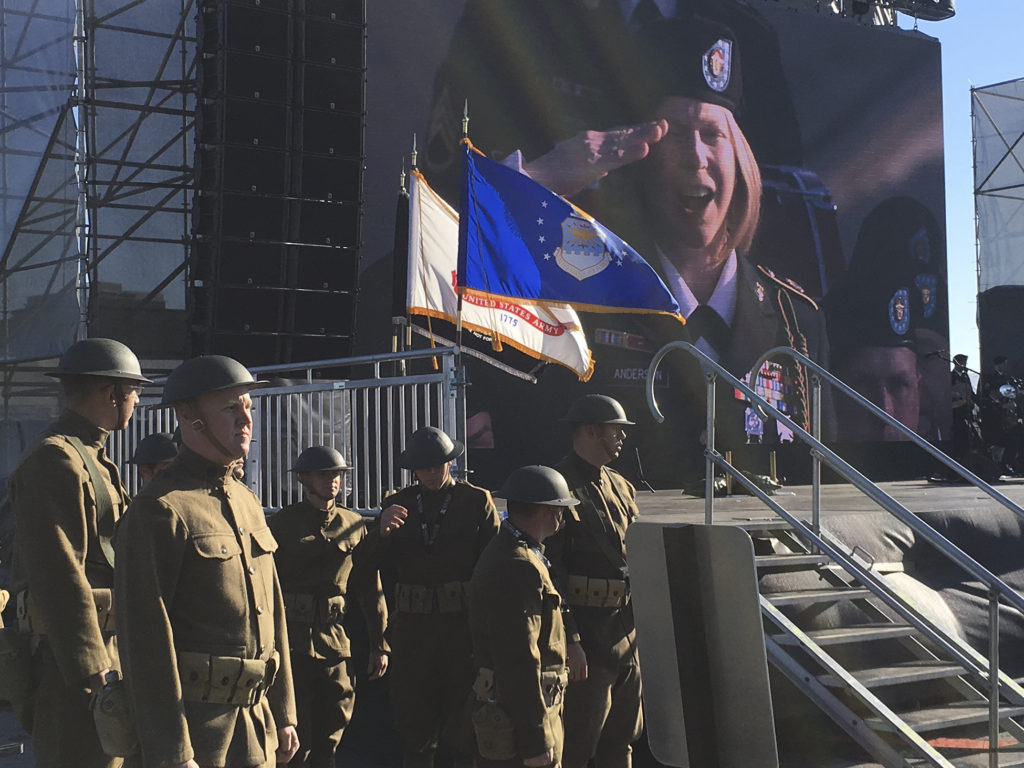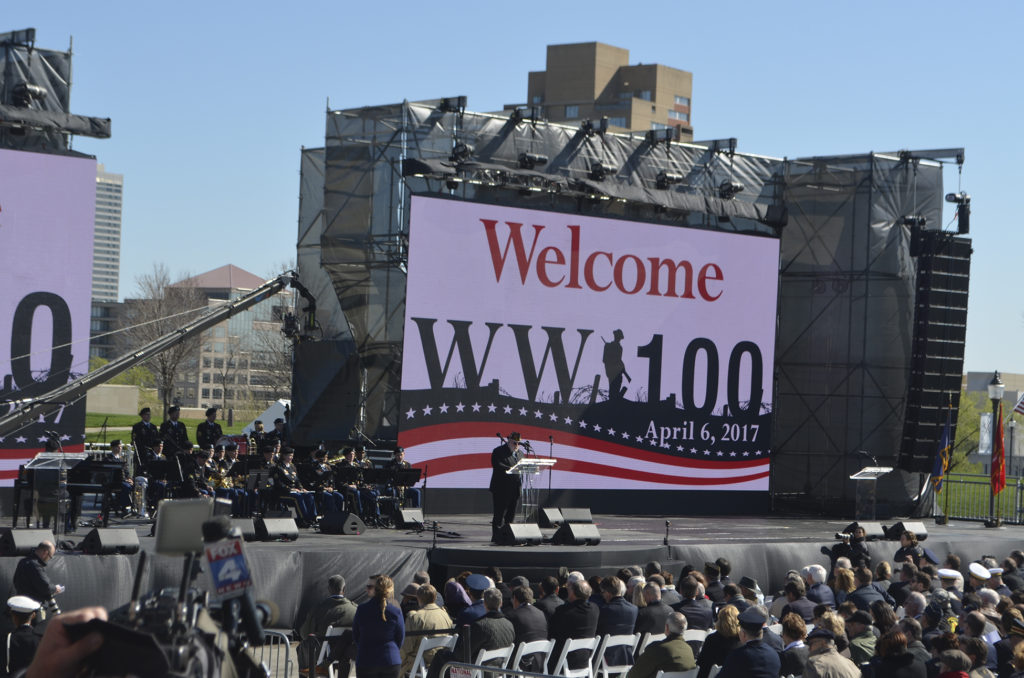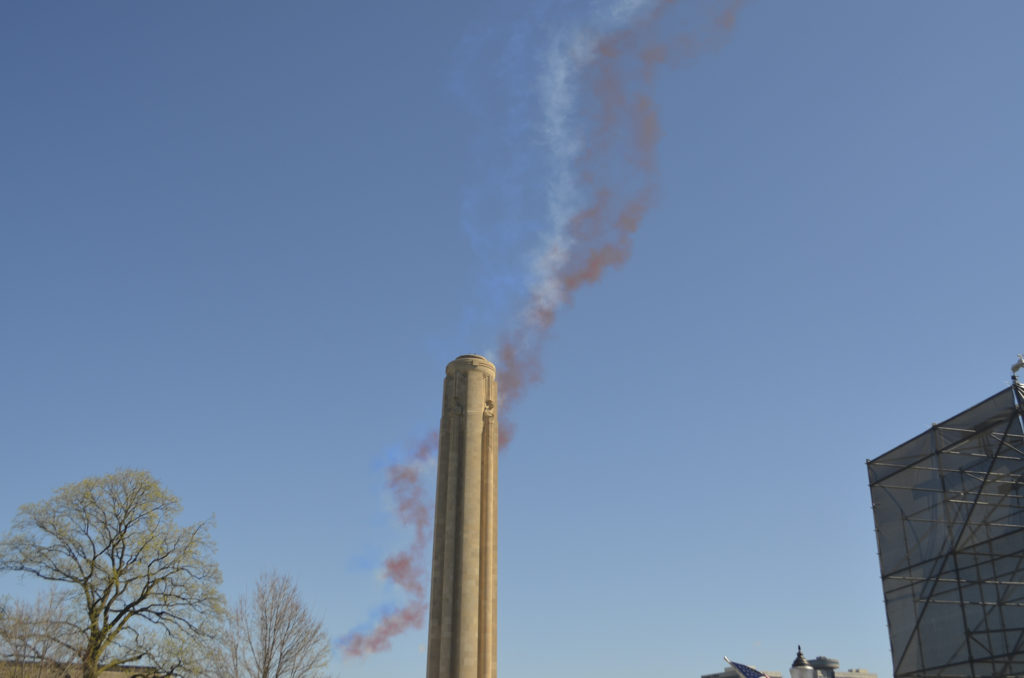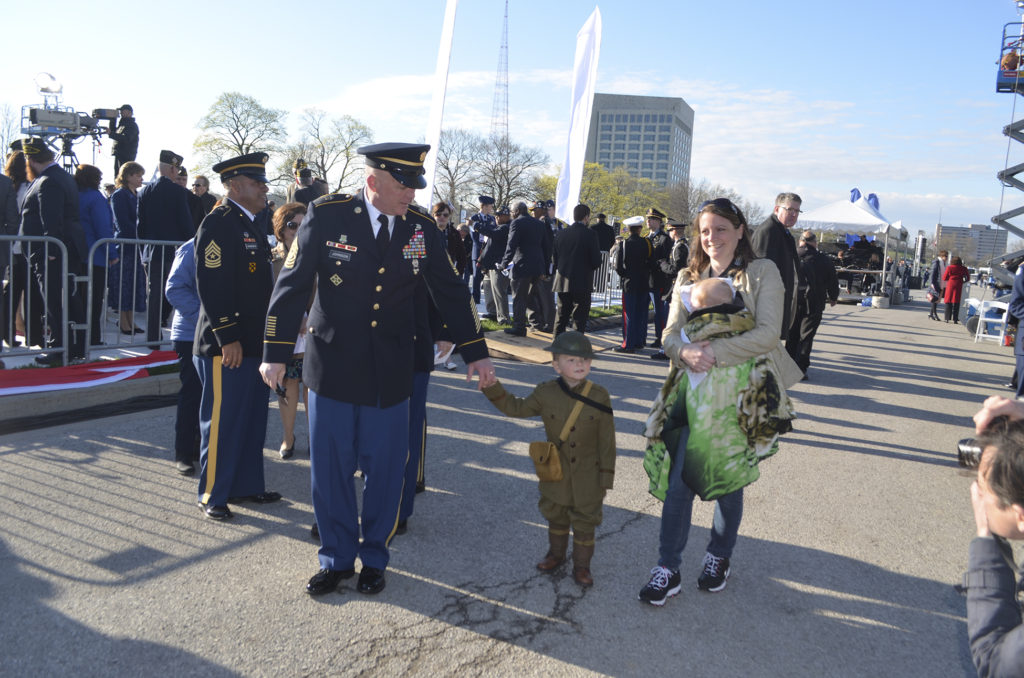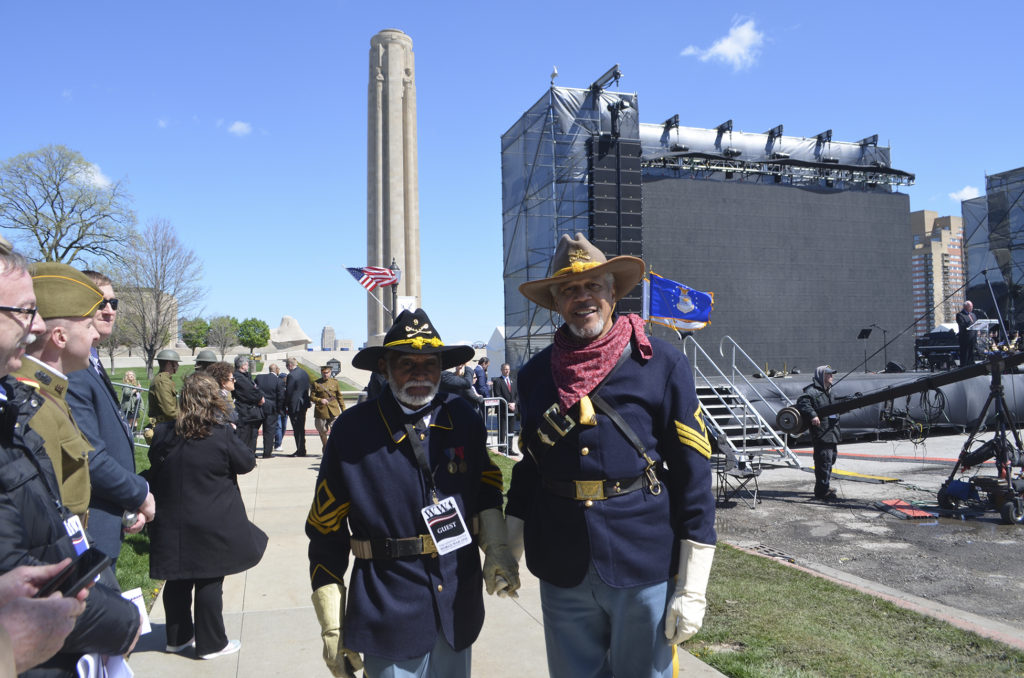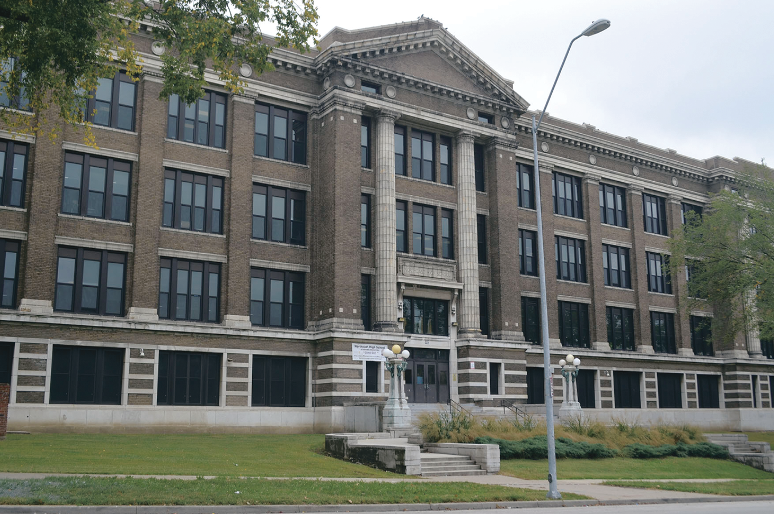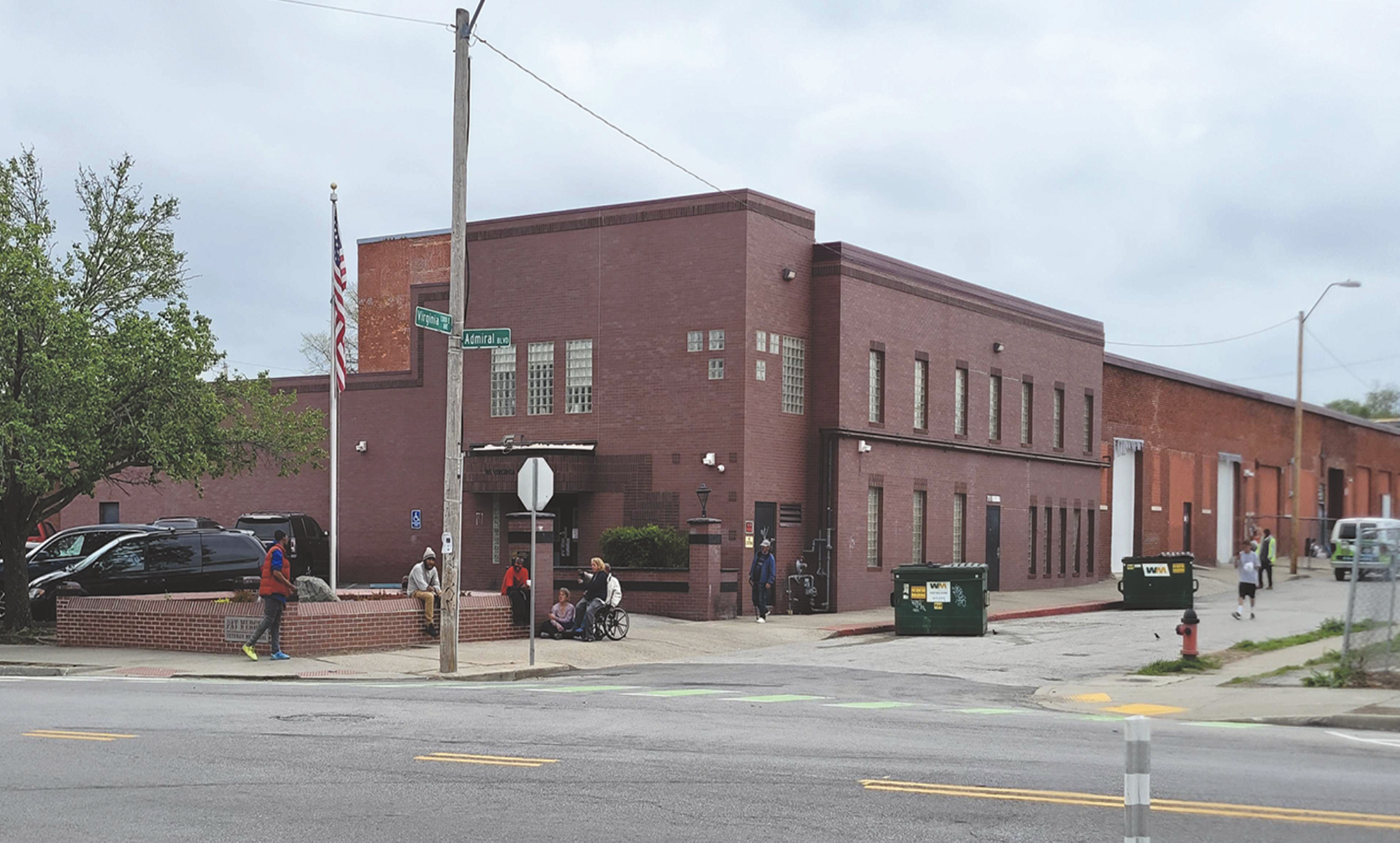Northeast News
April 7, 2017
KANSAS CITY, Missouri – On Thursday, April 6, on the 100th anniversary of United States engagement in the Great War, dignitaries from across the globe gathered under the shadow of the Liberty Memorial in Kansas City, Missouri for the World War I Centennial Commemoration.
Every branch of U.S. military service was represented at the event, as were 26 states and 27 countries throughout the world. A flyover by Patrouille de France pilots featured streaks of red, white, and blue colored smoke across the sky, and a U.S. Air Force B2 Stealth Bomber provided an additional aerial show with a climactic flyover of its own. Meanwhile, the firing of cannons by the 129th Field Artillery Regiment of Missouri’s Army Reserve National Guard offered a powerful display from the ground.
History took center stage during the emotional event, which opened with comments from relatives of infamous U.S. Generals George S. Patton and John “Blackjack” Pershing and also featured honored local dignitaries such as Kansas City, Missouri Mayor Sly James, U.S. Representative Emanuel Cleaver II, and Missouri Governor Eric Greitens. In his pre-ceremony address, Greitens discussed the World War I service of Missourian Frank Buckles, who ultimately became the final surviving American veteran of the war. Buckles, who was only 16 years old when the United States entered the war, died in February 2011 at the age of 110.
Greitens described how Buckles, in his eagerness to serve his country in the war effort, volunteered to drive an ambulance on the front lines. He then urged attendees to remember the sacrifice of Buckles and so many others.
“The surest way for our nation and our allies to continue to fight for the cause of freedom is to remember what we have done before,” said Greitens. “Let us pray to the memory of our honored dead that they may inspire us, such that 100 years from now our grandchildren’s grandchildren might gather here and say that we came here with courage, we were remembered with reverence, and we too rose to inspire peace and liberty in our time. Thank you, and God bless you all.”
Colonel Robert J. Dalessandro, retired Army veteran and Chair of the World War I Centennial Commission, expressed his great pride at being selected to head the Commission, which was established by Congress in January of 2013 with what Dalessandro described as the mission of “honoring the 4.7 million Americans who served in uniform during the conflict; educating Americans about the sacrifices of their predecessors in the Great War; and commemorating the participation of the United States and its citizens in Word War I – the war that changes the world that we live in.”
“The United States entered the war on April 6, 1917: the decision was not an easy one. As you’ll see in this ceremony, America entered the war to bring liberty, democracy and peace to the world after almost three years of unprecedented hardship, strife, and harm,” continued Dalessandro. “During the war, America saw dramatic changes in technology, in medicine, in civil rights, and in women’s suffrage. Our soldiers began the war on horseback and ended their efforts employing armored vehicles and airplanes.”
The ceremony itself included dramatic readings that depicted many of the most important moments in the lead-up to American involvement in World War I. Among those readings was a fascinating reenactment of a fundamental disagreement between U.S. President Woodrow Wilson and former Commander-in-Chief Theodore Roosevelt over whether the United States should maintain its isolationist stance as Europe devolved into a bloody war.
The debate raged ahead of the 1916 election, and it intensified as the recently-unleashed German U-boats would go on to sink over 90 ships in 1915.
“The example of America must be the example not merely of peace because it will not fight, but of peace because peace is the healing influence of the world,” said Wilson. “There is such a thing of a man being too proud to fight. There is such a thing of a nation being so right that it does not need to convince others by force that it is right.”
The infamous sinking of the RMS Lusitania in May of 1915 – which killed over 1,100 passengers including 128 Americans – served as a catalyst for American involvement in the war. Theodore Roosevelt compared the attack to the first shots of the Civil War at Fort Sumter.
“I am pretty well disgusted with our government, and the way our people acquiesce in and support it. I suppose, however, in a democracy like ours, the people will always do well or ill in proportion to their leadership,” said an enraged Roosevelt. “If Lincoln had acted after the firing on Sumter the way Wilson acted after the sinking of the Lusitania, in one month the North would have been saying they were so glad he kept them out of war, and that at all hazards, fratricidal war should be avoided.”
Kansas City Councilman Scott Taylor told the Northeast News that he was honored and emotional about the City’s role in hosting the World War I Centennial. He also praised KCPD’s efforts for making the large-scale event run as smoothly as possible.
“KCPD is the best in the country, and they know how to do large events,” said Taylor. “They showed that both at the All-Star game and when the Royals won the World Series and we had 800,000 of our closest friends here. They do a great job.”
Fellow KCMO Councilman Dan Fowler, a self-proclaimed history buff, said during the ceremony that he hoped the National World War I Museum would realize an attendance bump by serving as the host of the World War I Centennial.
“For me, this is outstanding to be here for this. Not only is this a great event, but it’s showcasing one of the best museums in the United States,” said Fowler. “People see the tower and the flame, but they don’t know the jewel that’s under it. It’s an incredibly well-done museum. This is at least equal, if not better, than anything. It shows the story from all the sides, and the devastation of this war in particular.”
On Friday, April 7, the National WWI Museum unveiled a new exhibit: Revolutions! 1917. The exhibit focuses on the events leading up to U.S. engagement in World War I, and features items on loan from other institutions, as well as some never-before-seen items. For more information, visit www.theworldwar.org.


